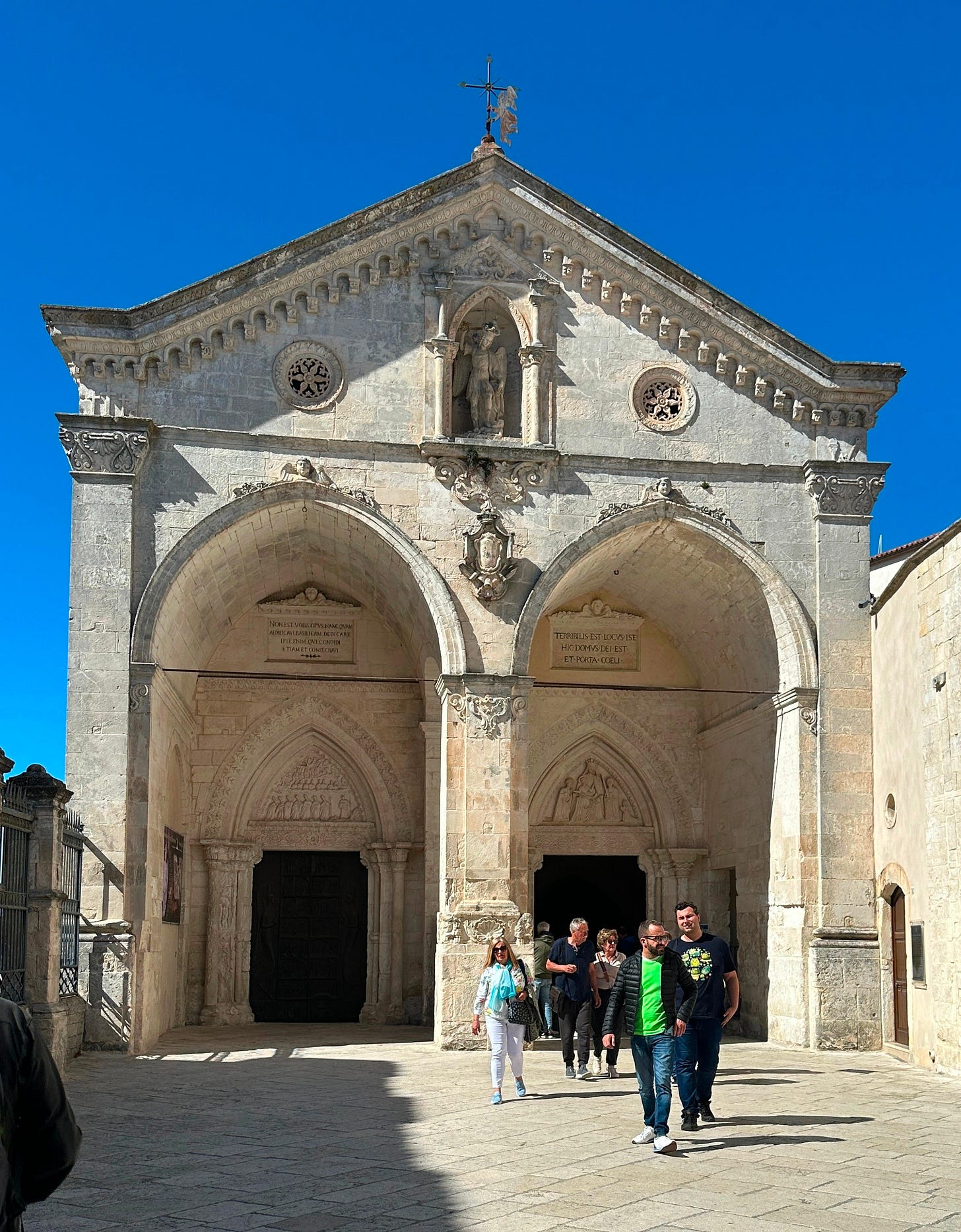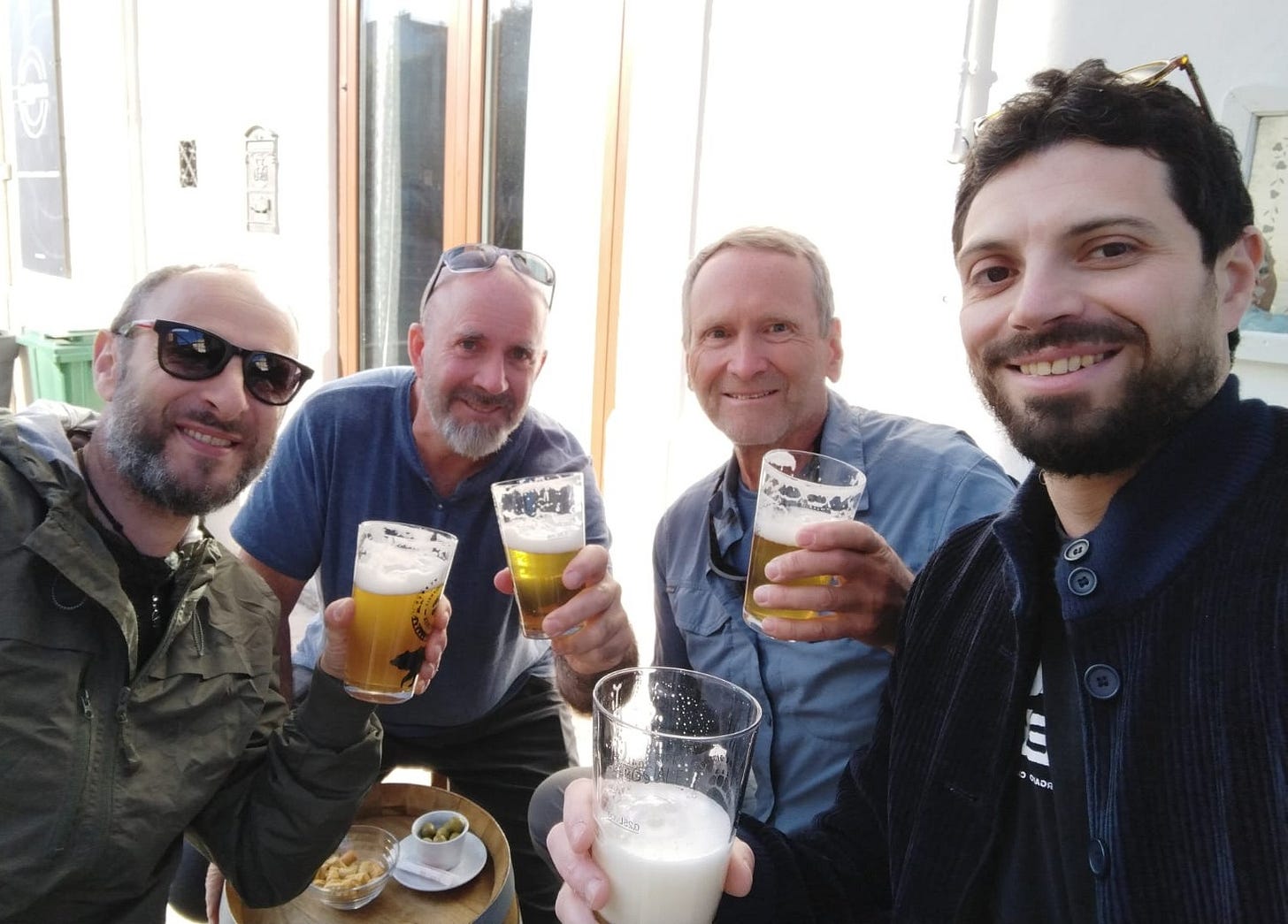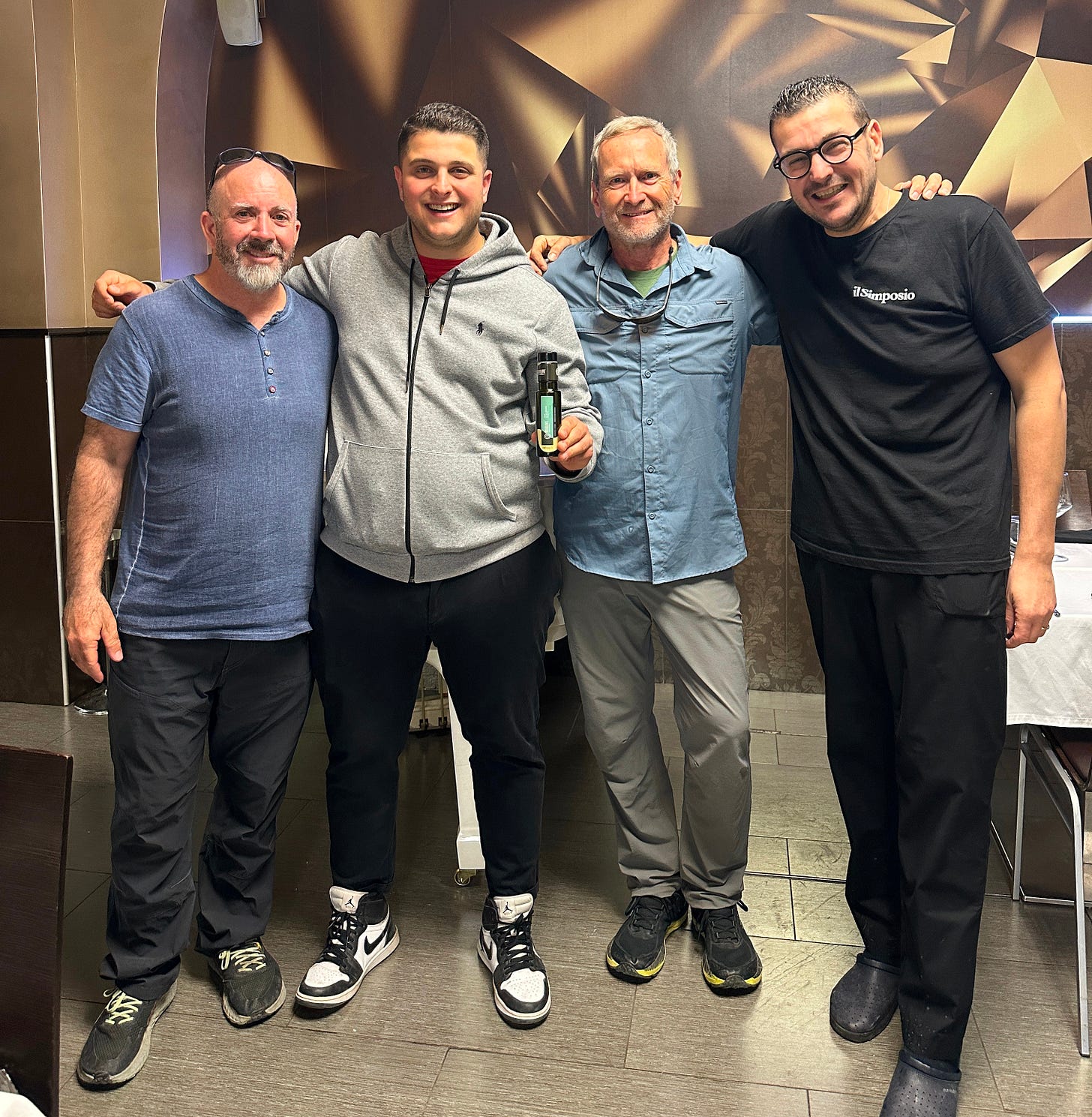Our six-week Italian trek began in Vieste, in coastal Apulia—kilometer zero. From here, we followed the pilgrimage trail of St. Michael through centuries-old olive groves and up into the Umbra forest, the lushest spot in Apulia. Umbra (Latin for shade) befits this forest due to the abundance of oaks and maples. Shade, though, does not always translate to water. There is some geologic trickery here that ensures no trailside fountains to drink from, and no creeks to dip our filters into, even after a night of heavy rain.1
We spent the first night under the trees, rationing our water supply, before descending into Gargano National Park. The spiritual heart of Gargano is undoubtedly Monte Sant‘Angelo, a ridgetop town overlooking the great plains of Apulia and the Adriatic Sea. Italy is riddled with catholic churches, sanctuaries, basilicas, and cathedrals, but Monte Sant’Angelo is exceptional in this regard. The first and most powerful archangel in the bible, Saint Michael, materialized as an apparition in a cave here 2,000 years ago. The site has since been a destination for pilgrims from nearly every continent on Earth.
While Bill searched the town for a fountain, I headed into the sanctuary of St. Michael, a minor basilica. The grandeur of the building compels one to approach slowly, and then walk through the bronze doors—carved with scenes from the old and new testaments—with respect. Once inside, I worked my way down several flights of stairs to the cave, which has been extended to include a stone-walled nave for mass. The priest’s voice was billowing from the mouth of the cave to a congregation of Catholics from around the globe, responding “prega per noi” in unison each time the priest called upon a saint for protection.2
Sanctuary of Saint Michael the Archangel, Monte Sant’Angelo, Italy. Photo by J.H. Giordanengo
The fountains of Monte Sant’Angelo were indeed dry. Thirsty, we worked our way down several cobblestone stairways and streets to our apartment to meet up with Giovanni. Giovanni lives in the country, but comes into town from time to time to manage our place. More importantly, he comes to Monte Sant’Angelo to connect with friends like Nicco, who runs Leko pub. We met up with Giovanni at Leko pub later that evening to enjoy prinsa (something between pizza and focaccia) and beer, and gained some unexpected insight.
The Culture of “Kilometer Zero”
It’s no secret that Italians produce a cornucopia of fine wines, cheese, and a wide range of other foods. Less obvious, Italian’s are beginning to master beer. Beer is trendy in Italy, and it’s more refreshing than wine on hot summer days. The national brands, similar in quality to Coors and Budweiser, can quench the thirst. But artisanal beer, crafted in small batches, is something entirely different. And I can attest, as someone from the beer mecca of Fort Collins, Colorado, the artisanal beer in this part of Apulia is exceptional.
Chatting with Giovanni about music, trekking, and of course food, we got onto the subject of regionalismo, the art of living locally. Giovanni referred to regionalismo (regionalism) in a way I’d never heard. He called it “kilometer zero.” In every region of Italy (except one, perhaps), deep pride exists in food and beverages that are not simply grown locally, but that are crafted in way that reflects the spirit of the people and the bounty of the land right here—at kilometer zero. The artisanal beer we enjoyed at Leko pub was “kilometer zero,” made by a master brewer who lives just down the road from Giovanni’s farm.
Left to right: Giovanni, John, Bill, and John at Leko Pub in Monte Sant’Angelo, Italy. Photo by J.H. Giordanengo.
Shortly after sunrise the next morning we followed another pilgrimage route, the Via Francigena,3 back down toward the hot plains of Apulia to connect with the “Tratturo Celano-Foggia,” an ancient shepherd’s road Giovanni told us about.4 We followed the tratturo to an abandoned railroad, followed it straight through nine miles of olive groves, and eventually reached Torremaggiore, rich in history and classic Apulian hospitality. A few “kilometer zero” experiences along the way included Amaro made from wild cherries,5 and caciocavallo cheese originating in the lush meadows surrounding the Umbra Forest.
Hours before dinner, the chef of Il Simposio shared another kilometer zero phenomenon: Peranzana olive oil. The Peranzana variety grows only in the vicinity of Torremaggiore, yielding a superb flavor. Locals also process Peranzana to make an oil extract that is famed for its anti-cancer properties.
Right: Chef Emilio Santobuono of Il Simposio restaurant in Torremaggiore, Apulia region. 2nd from Left: Manager of Il Simposio holding Peranzana oil.
Renewable energy is not exactly a kilometer zero phenomenon, but it has become very localized in Italy. We began exploring this over dinner with two young energy engineers, Alberto & Riccardo, who were working on a nearby solar energy facility. Besides the abundant rooftop solar systems, hydroelectric plants are prevalent in Italy’s mountainous regions, and it’s difficult to trek through Italy without passing by several small wind farms. In totally, about 41% of Italy’s electricity is met with renewables, and this California-sized nation is shooting for 60% renewable electricity by 2030.6 Based on the trends, and the cost-effectiveness of renewable energy, I’m guessing Italians will reach their goal by 2035.
Sun, wheat, and bread (in the land that doesn’t exist)
Happy to leave the hot plains, we followed a network of narrow roads and trails through wheat-covered hills and vineyards to Matrice, a small mountain town. Somewhere along the way, we crossed into the region of Molise. There is a running joke in Italy that Molise is so small and unpopulated that it doesn’t actually exist. For two Coloradoans with backpacks, this makes Molise the perfect place for trekking.
We settled into B&B Da Mary, and went out to dinner with Mary and her husband Angelo. Following the pasta course, a friend of theirs pulled up a chair and began chatting. Casually, he began dipping a sweet pretzel-shaped bread into his glass of red wine—and then he at it of course. Trying this, I was surprised how good it tasted.
Angelo, it so happens, makes the sweat bread at his family bakery, Panificio Petrella Laurino, and gave us a tour there the next morning. “It’s all kilometer zero,” Angelo began, referring to the diversity of breads they make. To him, kilometer zero is a 20-kilometer radius of restaurants and homes around Matrice, where customers wake up every day anticipating some fine bread for breakfast, lunch, or dinner.
“This stone ground wheat bread tastes to me like it has butter baked into it,” I told Angelo. Diplomatically, he assured me no such thing would ever happen in his bakery. Such rich flavors arise from the process used, and the quality of ingredients. This includes a local variety of durum wheat called Cappelli. Angelo’s wheat bread also relies on natural leavening. That is, the wild yeast spores floating through the air in Matrice are a key ingredient, rather than commercially produced yeast.
It comes as no surprise that Angelo’s bakery is powered by a large rooftop solar system. The great surprise is the cost savings. This system reduces his energy bill by more than 50%. Kilometer zero energy also bolsters Italy’s GDP and keeps more hard-earned money in the hands of locals, while nuclear energy imported from France does neither.
Angelo Petrella of Panificio Patrella Laurino bread company in Matrice (Molise region, Italy). Photo by J.H. Giordanengo.
Step by step, we made our way through Molise and into Abruzzo. On the trail, chatting about wine-soaked bread and amazing pasta, we began seeing the high peaks of Gran Sasso National Park rising in the distance. And eventually, a key difference between regionalismo and kilometer zero would emerge.
Summer Books and Fall Talks
For a deeper read on sustainable regional economies, digital and paperback copies of Ecosystems as Models for Restoring our Economies (To a Sustainable State) are available at Anthem Press and elsewhere. Upcoming talks and workshops on economic restoration are listed here.
Notes
The geology in Gargano is a limestone-based karst system, which tends to be highly porous, yielding few to no streams and springs.
Common in Catholicism, the priest was calling upon a long list of saints for protection and support, to which the congregation was responding “prey for us.”
The Via Francigena is one of the longest pilgrimage routes in the world, from Canterbury England to Rome, Italy, with an optional spur to Palestine that goes through Monte Sant’Angelo.
The tratturos of southern Italy are ancient paths shepherds used to move their flocks seasonally, in search of good summer and winter pasture.
Amaro is a grape-based liquor common in Italy, typically infused with fruits, herbs, and roots. The alcohol for amaro is often grappa, which is distilled into a 40-50 percent alcohol from the remains of wine-making.
Enerdata. 2025. ‘Renewable sources covered a record 41% of Italy’s power demand in 2024.’ Enerdata. Accessed 13 June, 2025. https://www.enerdata.net/publications/daily-energy-news/renewable-sources-covered-record-41-italys-power-demand-2024.html#:~:text=According%20to%20the%20Italian%20power,hydropower%20and%20solar%20PV%20generation.







